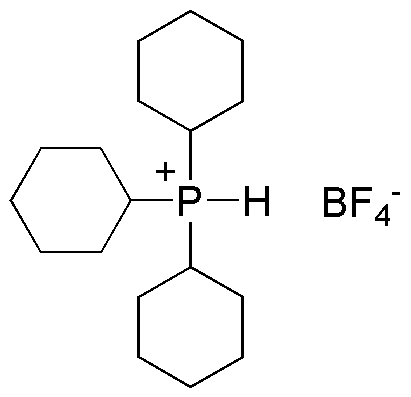Tricyclohexylphosphine tetrafluoroborate is widely utilized in research focused on:
- Catalysis: This compound serves as a highly effective ligand in various catalytic reactions, enhancing the efficiency of processes in organic synthesis, particularly in the production of fine chemicals.
- Organometallic Chemistry: It plays a crucial role in stabilizing metal complexes, making it valuable for researchers working on new materials and catalysts in organometallic chemistry.
- Pharmaceutical Development: The compound is used in drug synthesis, aiding in the development of pharmaceutical intermediates that require precise chemical transformations.
- Material Science: Its unique properties allow for the creation of advanced materials, including polymers and coatings, which are essential in industries such as electronics and automotive.
- Research and Development: It is frequently employed in academic and industrial laboratories for various experimental setups, providing researchers with a reliable tool for exploring new chemical pathways.
General Information
Properties
Safety and Regulations
Applications
Tricyclohexylphosphine tetrafluoroborate is widely utilized in research focused on:
- Catalysis: This compound serves as a highly effective ligand in various catalytic reactions, enhancing the efficiency of processes in organic synthesis, particularly in the production of fine chemicals.
- Organometallic Chemistry: It plays a crucial role in stabilizing metal complexes, making it valuable for researchers working on new materials and catalysts in organometallic chemistry.
- Pharmaceutical Development: The compound is used in drug synthesis, aiding in the development of pharmaceutical intermediates that require precise chemical transformations.
- Material Science: Its unique properties allow for the creation of advanced materials, including polymers and coatings, which are essential in industries such as electronics and automotive.
- Research and Development: It is frequently employed in academic and industrial laboratories for various experimental setups, providing researchers with a reliable tool for exploring new chemical pathways.
Documents
Safety Data Sheets (SDS)
The SDS provides comprehensive safety information on handling, storage, and disposal of the product.
Product Specification (PS)
The PS provides a comprehensive breakdown of the product’s properties, including chemical composition, physical state, purity, and storage requirements. It also details acceptable quality ranges and the product's intended applications.
Certificates of Analysis (COA)
Search for Certificates of Analysis (COA) by entering the products Lot Number. Lot and Batch Numbers can be found on a product’s label following the words ‘Lot’ or ‘Batch’.
*Catalog Number
*Lot Number
Certificates Of Origin (COO)
This COO confirms the country where the product was manufactured, and also details the materials and components used in it and whether it is derived from natural, synthetic, or other specific sources. This certificate may be required for customs, trade, and regulatory compliance.
*Catalog Number
*Lot Number
Safety Data Sheets (SDS)
The SDS provides comprehensive safety information on handling, storage, and disposal of the product.
DownloadProduct Specification (PS)
The PS provides a comprehensive breakdown of the product’s properties, including chemical composition, physical state, purity, and storage requirements. It also details acceptable quality ranges and the product's intended applications.
DownloadCertificates of Analysis (COA)
Search for Certificates of Analysis (COA) by entering the products Lot Number. Lot and Batch Numbers can be found on a product’s label following the words ‘Lot’ or ‘Batch’.
*Catalog Number
*Lot Number
Certificates Of Origin (COO)
This COO confirms the country where the product was manufactured, and also details the materials and components used in it and whether it is derived from natural, synthetic, or other specific sources. This certificate may be required for customs, trade, and regulatory compliance.


